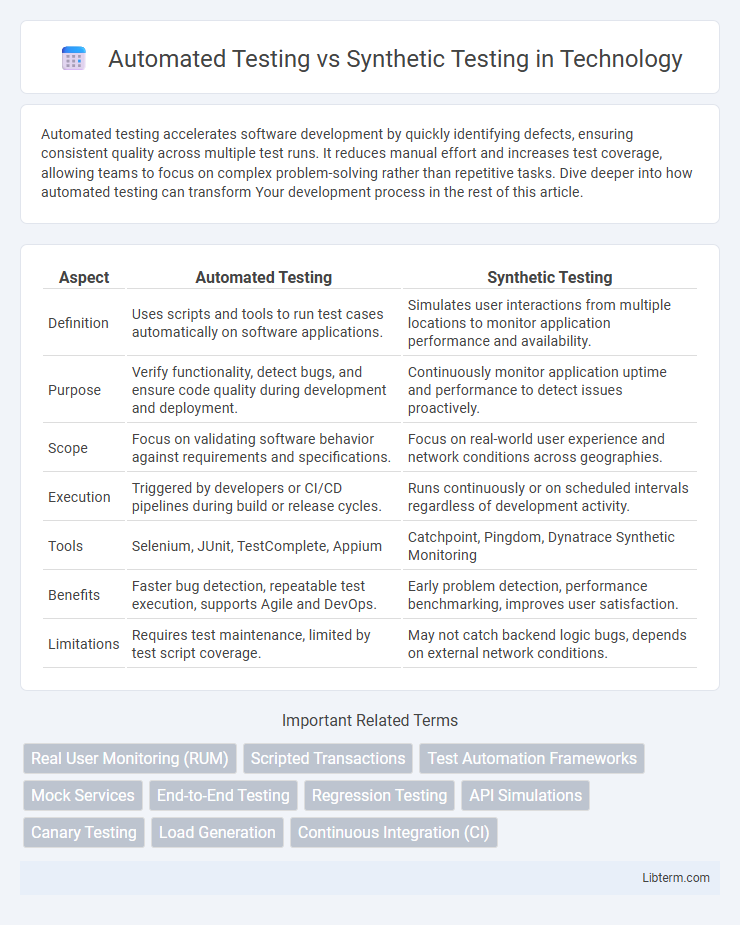Automated testing accelerates software development by quickly identifying defects, ensuring consistent quality across multiple test runs. It reduces manual effort and increases test coverage, allowing teams to focus on complex problem-solving rather than repetitive tasks. Dive deeper into how automated testing can transform Your development process in the rest of this article.
Table of Comparison
| Aspect | Automated Testing | Synthetic Testing |
|---|---|---|
| Definition | Uses scripts and tools to run test cases automatically on software applications. | Simulates user interactions from multiple locations to monitor application performance and availability. |
| Purpose | Verify functionality, detect bugs, and ensure code quality during development and deployment. | Continuously monitor application uptime and performance to detect issues proactively. |
| Scope | Focus on validating software behavior against requirements and specifications. | Focus on real-world user experience and network conditions across geographies. |
| Execution | Triggered by developers or CI/CD pipelines during build or release cycles. | Runs continuously or on scheduled intervals regardless of development activity. |
| Tools | Selenium, JUnit, TestComplete, Appium | Catchpoint, Pingdom, Dynatrace Synthetic Monitoring |
| Benefits | Faster bug detection, repeatable test execution, supports Agile and DevOps. | Early problem detection, performance benchmarking, improves user satisfaction. |
| Limitations | Requires test maintenance, limited by test script coverage. | May not catch backend logic bugs, depends on external network conditions. |
Introduction to Automated Testing and Synthetic Testing
Automated testing uses software tools and scripts to execute pre-defined test cases on applications, improving efficiency and accuracy in identifying defects during development. Synthetic testing involves simulating user interactions with applications in a controlled environment to proactively monitor performance and availability. Both methods play crucial roles in quality assurance by ensuring software reliability through continuous and repeatable validation processes.
Key Definitions: What is Automated Testing?
Automated testing is a software quality assurance process that uses specialized tools and scripts to execute pre-defined test cases without human intervention, ensuring consistent and repeatable validation of application functionality. It enables rapid detection of defects by automatically running regression tests, unit tests, or integration tests across different environments and platforms. This testing approach improves efficiency, accuracy, and coverage compared to manual testing methods.
Understanding Synthetic Testing: Core Concepts
Synthetic testing involves creating scripted transactions that simulate user interactions with an application to monitor performance and availability continuously. It enables proactive identification of issues by generating consistent, repeatable tests in controlled environments, independent of real user traffic. These tests provide detailed insights into system behavior under various conditions, supporting early detection of outages and performance bottlenecks.
Major Differences Between Automated and Synthetic Testing
Automated testing involves running predefined test scripts on software applications to identify defects and validate functionality, primarily focusing on real user scenarios within the development environment. Synthetic testing simulates user interactions in a controlled environment to proactively monitor application performance and availability from multiple geographic locations, emphasizing uptime and experience metrics. The major differences lie in their purpose--automated testing targets functional correctness during development, while synthetic testing focuses on continuous performance monitoring and user experience outside of live traffic.
Use Cases: When to Use Automated Testing
Automated testing is ideal for repetitive, regression, and functional test cases where scripts can execute extensive test suites efficiently and consistently, ensuring rapid detection of software defects. It is particularly effective in continuous integration and continuous deployment (CI/CD) pipelines, enabling frequent code changes to be tested with minimal manual intervention. Automated testing is best suited for applications with stable requirements and large-scale testing needs that benefit from consistent and repeatable test execution.
Use Cases: When to Use Synthetic Testing
Synthetic testing is ideal for monitoring application performance and availability in a controlled environment before users encounter issues, particularly in critical systems such as e-commerce platforms and financial services. It enables proactive identification of downtime, latency, and functional failures through scripted interactions that mimic user behavior outside of real-user traffic. This approach complements automated testing by providing continuous, predictable insights into system health, crucial for SLA compliance and incident prevention.
Pros and Cons of Automated Testing
Automated testing excels in rapidly executing repetitive test cases, increasing efficiency and coverage while reducing human error and operational costs. However, it requires significant upfront investment in tools and scripting expertise, and may struggle with detecting visual or usability issues compared to manual or synthetic testing. Maintenance of automated test scripts can be resource-intensive, especially in dynamic application environments where frequent changes occur.
Advantages and Limitations of Synthetic Testing
Synthetic testing offers proactive monitoring by simulating user interactions to detect performance issues before real users are affected, providing continuous availability insights and detailed metrics on application responsiveness. It is advantageous for identifying potential outages and measuring transaction times under controlled conditions but is limited by its inability to capture the full complexity of real-user behavior and requires maintenance to keep test scripts updated with application changes. While synthetic testing ensures consistent baseline performance data, it cannot fully replace automated testing, which benefits from testing real application environments and diverse user scenarios.
Choosing the Right Testing Strategy for Your Application
Automated testing leverages scripts and tools to execute predefined test cases rapidly, ideal for regression and functional testing in dynamic application environments. Synthetic testing simulates user interactions from various locations to monitor application performance and uptime, providing proactive detection of issues before end-users are affected. Selecting the right strategy depends on application complexity, testing goals, and the need for continuous monitoring versus in-depth functional validation.
Future Trends in Automated and Synthetic Testing
Future trends in automated and synthetic testing emphasize AI-driven analytics and machine learning algorithms to enhance test accuracy and reduce false positives. Integration of cloud-based platforms enables scalable, continuous testing environments that simulate real-user interactions and complex scenarios in real-time. Emerging technologies like robotic process automation (RPA) and predictive analytics optimize test coverage, improve defect detection, and accelerate release cycles across diverse software ecosystems.
Automated Testing Infographic

 libterm.com
libterm.com